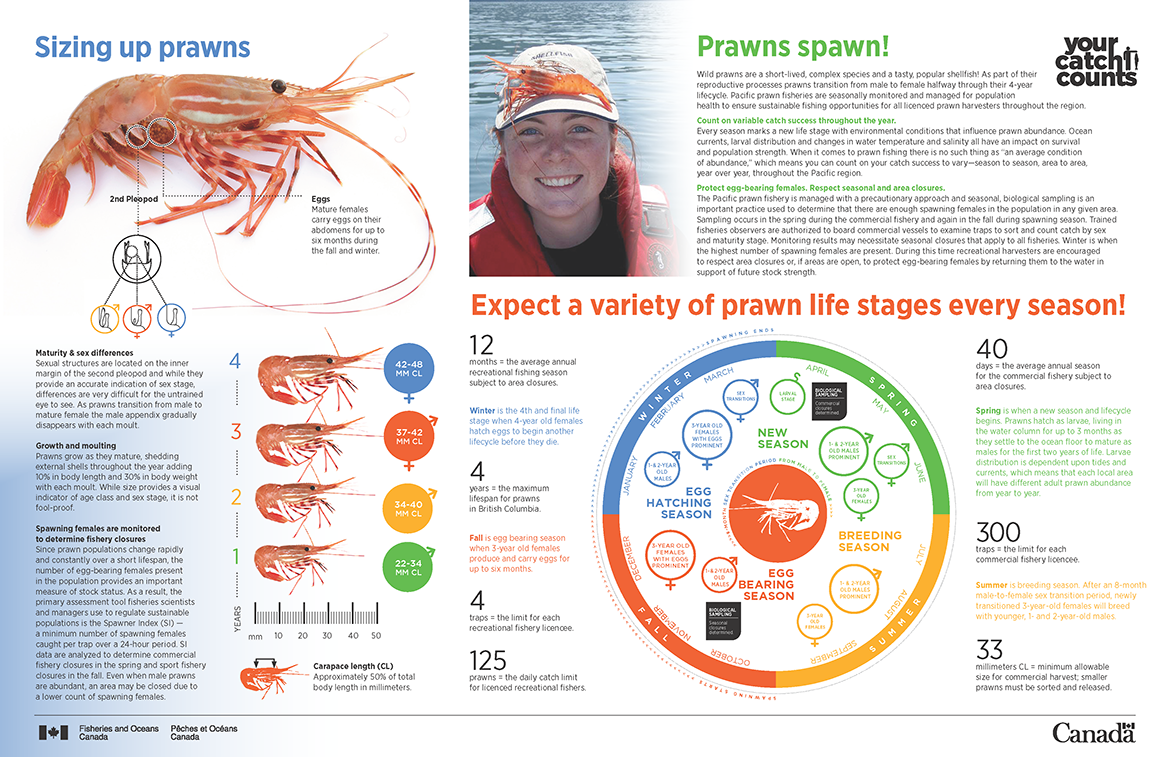Prawns spawn

Description: Prawns spawn
Prawns spawn
Wild prawns are a short-lived, complex species and a tasty, popular shellfish! As part of their reproductive processes prawns transition from male to female halfway through their 4-year lifecycle. Pacific prawn fisheries are seasonally monitored and managed for population health to ensure sustainable fishing opportunities for all licenced prawn harvesters throughout the region.
Count on variable catch success throughout the year
Every season marks a new life stage with environmental conditions that influence prawn abundance. Ocean currents, larval distribution and changes in water temperature and salinity all have an impact on survival and population strength. When it comes to prawn fishing there is no such thing as “an average condition of abundance,” which means you can count on your catch success to vary—season to season, area to area, year over year, throughout the Pacific region.
Protect egg-bearing females. Respect seasonal and area closures
The Pacific prawn fishery is managed with a precautionary approach and seasonal, biological sampling is an important practice used to determine that there are enough spawning females in the population in any given area. Sampling occurs in the spring during the commercial fishery and again in the fall during spawning season. Trained fisheries observers are authorized to board commercial vessels to examine traps to sort and count catch by sex and maturity stage. Monitoring results may necessitate seasonal closures that apply to all fisheries. Winter is when the highest number of spawning females are present. During this time recreational harvesters must respect area closures or, if areas are open, to protect egg-bearing females by returning them to the water in support of future stock strength
Expect a variety of prawn life stages every season
| What you can expect to see | What's important this season | |
|---|---|---|
| Spring (Apr-June) New Season |
|
New lifecycle begins. New larvae may not be visible but they live in the upper water column for up to 3 months as they settle to the ocean floor. Once settled, they mature as males for the first two years of life. Larvae distribution is dependent upon tides and currents, which means that each local area will have different adult prawn abundance from year to year |
| Summer (July-Sept) Breeding Season |
|
After an 8-month male-to-female sex transition period, newly transitioned 3-year-old females will breed with younger, 1- and 2-year-old males. |
| Fall (Oct-Dec) Spawning Season |
|
Spawning starts in October. Large, mature, egg-bearing females increase in prominence and seasonal closures will be in effect to protect them. |
| Winter (Jan-Mar) Egg Season |
|
Winter closures will be in effect to protect large, mature, egg-bearing females as their eggs prepare to hatch before the 4-year lifecycle ends. |
- 12 months = the average annual recreational fishing season subject to area closures
- 4 years = the maximum lifespan for prawns in British Columbia
- 4 traps = the limit for each recreational fishery licencee
- 125 prawns = the daily catch limit for licenced recreational fishers
- 40 days = the average annual season for the commercial fishery, subject to area closures
- 300 traps = the limit for each commercial fishery licencee
- 33 millimeters CL = minimum allowable size for commercial harvest; smaller prawns must be sorted and released
Sizing up prawns
Diagram of prawn with the following:
- Eggs: Mature femalescarry eggs on their abdomens for up tosix months during the fall and winter.
- 2nd pleopod
Maturity and sex differences
Sexual structures are located on the inner margin of the second pleopod and while they provide an accurate indication of sex stage, differences are very difficult for the untrained eye to see. As prawns transition from male to mature female the male appendix gradually disappears with each moult.
Growth and moulting
Prawns grow as they mature, shedding external shells throughout the year adding 10% in body length and 30% in body weight with each moult. While size provides a visual indicator of age class and sex stage, it is not fool-proof.
Spawning females are monitored to determine fishery closures
Since prawn populations change rapidly and constantly over a short lifespan, the number of egg-bearing females present in the population provides an important measure of stock status. As a result, the primary assessment tool fisheries scientists and managers use to regulate sustainable populations is the Spawner Index (SI) — a minimum number of spawning females caught per trap over a 24-hour period. SI data are analyzed to determine commercial fishery closures in the spring and sport fishery closures in the fall. Even when male prawns are abundant, an area may be closed due to a lower count of spawning females.
Chart of prawns with the following:
- 1 year: 22-34 mm carapace length
- 2 years: 34-40 mm carapace length
- 3 years: 37-41 mm carapace length
- 4 years: 42-48 mm carapace length
Carapace length (CL): Approximately 50% of total body length in millimeters.
- Date modified: